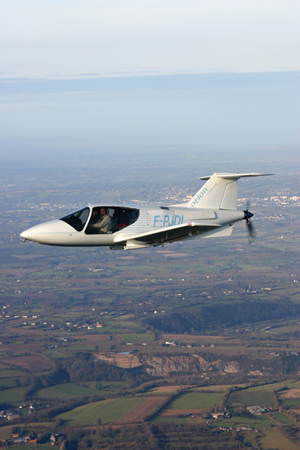
Twenty-five years ago, the composites revolution was under way with a profusion of sleek new designs from the U.S.: the Rutan VariEze, Lance Neibauer’s Lancair and the Stoddard-Hamilton Glasair. Those are names we all know, but here’s one you might not: the Grinvalds G-801 Orion. Inspired perhaps by earlier and contemporary “pusher” homebuilt designs such as the Bede BD-5 and the VariEze, aircraft designer Jean Grinvalds’ prototype G-801 Orion was a four-seat homebuilt constructed from plans. It first flew on June 2, 1981. In the U.S., two similarly conceived pusher homebuilt/kit designs, the Prescott Pusher and the Cirrus VK-30, didn’t fly until 1985 and 1988 respectively. Grinvalds was way ahead of the game.
Grinvalds started design work on a composite pusher concept in January 1975. He flew a radio-controlled scale model of his project, now named Orion, in July 1977. The prototype Grinvalds G-801 Orion, the plansbuilt version, first flew at Brienne-le-Chateau in France in June 1981; a second example, now called the G-802 and built from kit components, flew in late 1983.
Tragedy intervened in the Orion story in the spring of 1985 when Grinvalds and a French magazine reporter were killed when the prototype G-802 crashed. Entry to a spin at low level is widely considered the cause. French aviation authorities grounded all G-802s and demanded wind tunnel tests and full static testing of the airframe, which were carried out by Guy Staffler and Martin Schinzig on a G-802 under construction in France.
Aerodis America was formed with the hope of breaking into the U.S. market with sales of kit components of the Orion, but it came to nothing after the crash of the prototype and subsequent litigation. About 50 sets of plans for the G-801 were sold. Molds for the main airframe components were available in the hangars of the former USAF base at Brienne-le-Chateau, and many builders came to Brienne to fabricate composite components for Orions. Aerodis, the French company, was based at La Chapelle Saint Luc near Troyes Airport in France, built and sold about 70 component kits.
A Truly Rare Bird
About 17 examples of the G-801 and G-802 had been completed and flown worldwide by early 2008, mainly in France, but there are also nine examples about to fly soon including ones in Italy, Sweden, Canada and the U.S.
This Orion, constructed by 67-year-old Jean-Dominique Leullier (Jean-Dom for short) and Pat Leullier at Caen, emphasizes the design’s high points. Speed, economy of operation, great visibility and good looks were the main factors that attracted Jean-Dom and Pat. Jean-Dom had never built a homebuilt before, saw a photo of an Orion in a magazine and said, echoing the idiomatic catch phrase, “I want one of those.”
To understand the Orion, a brief journey into its construction profile is helpful. Composite shells make up the main airframe shape. The fuselage is formed from fiberglass/polyester and the original wing from a fiberglass/epoxy sandwich. Jean-Dom considered the tightrope between keeping the weight down yet maximizing the airframe strength. From the weight perspective he would have preferred to use vinylester instead of polyester to build the wing, because it wets the glass more easily during the layup construction process, resulting in lighter parts. The one-piece wing and one-piece H-spar, at nearly 30 feet long, require a large construction space, but Jean-Dom fabricated this at Brienne, and it was one of the many components he trucked back to his home near Caen.
The undercarriage was designed by Grinvalds and built for Jean-Dom by French engineering company Thebaud, based in Bourges. It is made of composites but is as strong as steel. One of the real tricky construction elements was fitting this retractable undercarriage. Jean-Dom devised a rotisserie device so he could turn or roll the fuselage to any position or angle he wanted.
Powered On
The engine, a 200-horsepower Lycoming IO-360 taken from a Piper Seneca, had to be installed at an early stage. The driveshaft from the engine to the tail-mounted propeller is what’s really different about the Orion. Originally, the driveshaft was steel between the flexidyne plate and the three-blade Muhlbauer MTV-18 electric constant-speed propeller. In this configuration, the system layout was: engine, then flexidyne plate, sliding sleeve, a Flector coupling, steel shaft (supported by one ball-element bearing in a cage close to the tail) and then the propeller.
The driveshaft system gave Jean-Dom problems in a spectacular way in 1999. One of the counterweights on the shaft had been inadequately welded and it started to crack, spreading around the shaft like the peeling of an orange. The shaft ruptured, vibration increased dramatically, and the engine stopped by itself. He could hear the propeller spin freely in the back, so he made a dead-stick landing in a plowed field.
During the rebuild, Jean-Dom opted for a lighter (and stronger) carbon-fiber shaft manufactured especially for him by ACPT of Huntington Beach in California. He also changed the prop to a three-blade variable-pitch Ivoprop and added a second Flector coupling.
During the construction process, the engine was installed following the
attachment of the one-piece wing and the undercarriage, fitted so that the Orion could stand on its own feet. Engine installation is an awkward task compared to bolting it to the front of the fuselage, but the use of a hydraulic jack made it easier. The mount is traditional tubular steel cantilever, built to Jean-Dom’s personal specification, through regular Dynafocal elastomeric sandwich mounts. Engine cooling and stray exhaust emissions could have been a problem in a pusher configuration, but with careful ducting (there are two main air scoops under the fuselage) the challenges have been met.
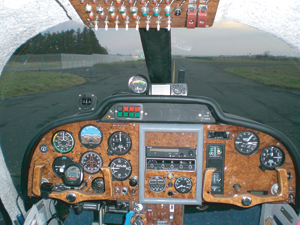
Typically equipped for this period of homebuilts, the Orion is capable of VFR travel. Note the superb over-the-nose visibility
Cabin Class
Getting seated in the Orion requires a degree of agility, and if you are not tall like Jean-Dom, a small box or step is preferable. You open the clam-shell doors that stay open on a gas strut and can be left open while taxiing (the engine and propwash are behind the cockpit), position your behind on the door sill and edge of the front seat, and then swing your legs in one at a time. For rear-seat passengers it is more of a scramble and crawl. The tendency in conventional aircraft to exit the cockpit and move behind the trailing edge of the wing is removed in the Orion, because the wing is behind the cockpit and the obvious (and only) way to exit is in front of the wing (and away from the prop).
The seating position is more reclined than upright, but quite comfortable. The rudder pedals with toe brakes are in an easy position, and the general ambiance is more like an airliner, with an overhead panel of switches and circuit breakers. An addition to the panel, and one I was to find a welcome aid during the approach and landing phase, is the Alpha Systems AOA (angle of attack) instrument. The Orion, as with some homebuilt types, does have a stall warning horn fitted, but the AOA instrument in such a sleek machine is vital.
Everything else is conventional to anyone used to a standard Cessna: rudder pedals with toe brakes (just on the left side), electrically operated two stage flaps 10° and 45°, central throttle, plenty of circuit breakers and other switches. Once the tremendous forward view is familiar, everything else fits into place. The noise behind you from the centrally mounted engine compartment is strange, but even this fades as you concentrate on systems, checks, taxiing and flying. Noise levels will soon be reduced with the addition of a new muffler.
Starting is assisted, and greatly benefited when the engine is hot, by two Light Speed Engineering electronic ignition systems. Taxiing is assisted in tight turns and locations by the toe operated Matco brakes and free-castering nosewheel.
Flying Colors
The Orion is not a short field or grass runway aircraft. Like other contemporary high-performance homebuilts and kit aircraft, it needs a longish, hard runway. At Caen, in almost still air conditions, this meant an estimated ground roll of 1640 feet with half tanks and two on board. At 65 knots indicated (KIAS) with a gentle pull back on the yoke, the nose lifts and the Orion is flying. You must follow with a bit of forward yoke pressure to prevent over-rotating. With the gear retracted, the Orion climbs at an acceptable 800 fpm with the speed building to 80 KIAS; power was set at 25 inches of manifold pressure and 2500 rpm. At about 300 feet agl it’s time to stow the electrically actuated flaps by the flick of a switch, and the speed moves quickly through 90 KIAS as the climb rate improves to 1500 fpm—good for an airplane that grosses at 2310 pounds (against a typical empty weight of around 1400 pounds.)
At 3000 feet msl, I set the Orion at 23 inches/2300 rpm for best economy cruise performance. At this setting, the airspeed indicator hung on 150 knots, almost 160 knots true. (Predicted maximum cruise is listed as 165 KTAS.) By this time the novelty of engine noise behind has diminished. I find the controls a little heavy and sensitive but well balanced. Over his 360 hours of flight time with the Orion, Jean-Dom has established the best cruise at 155 KTAS, which gives the Orion an endurance of 8+ hours on its two tanks totaling 69 gallons.
Quick Then Slow
The stall is quite benign at 65 knots IAS clean and 55 KIAS with flaps. I slowly reduce the throttle and set fine pitch on the propeller. The AOA instrument goes to Alpha and with the VSI on zero. Seventy knots comes up on the GPS. Chopping the throttle completely, the Orion slows, the AOA needle falls two increments, and there’s a slight buffet. The GPS shows 65 knots and then at 63 there’s a slight left wing drop, almost the start of a roll, but nothing dramatic. Recovered, we’ve lost little more than 100 feet, so I decide to repeat the exercise but with full 45° flap. This time I chop the throttle completely and lower the landing gear as if about to land. Again two increments below Alpha on the AOA and there’s a slight buffet at 58 knots on the GPS with the stall developed at 56.
With knowledge and experience of the stall speed, the approach is at a slightly higher speed than most light aircraft pilots are used to; 110 KIAS to start and application of 10° of flap, and lower the undercarriage plus turn on the landing lights (which are cleverly incorporated on the undercarriage doors and fair into the rear of the underwing air-scoops when retracted). Slowing to 95 KIAS and then 90, you have to be careful to keep your speed up, trying not to raise the nose and yet slow the aircraft. The AOA instrument is invaluable here, though I found I was mesmerized keeping my eye on ensuring that the needle was in the lower part of the yellow arc, rather than watching the rest of the instruments. With time this becomes a part of your normal instrument scan during approach and landing, and a backup to the essential airspeed indicator.
On final, the flaps can be lowered to 45°, with the speed now at 70 KIAS. Just before touchdown, the AOA needle should be at Alpha, just between the yellow and red arcs representing 60 knots. If this all works well and you keep the Orion in an almost flat attitude (limited flare), it will kiss the runway beautifully.
When Jean-Dom stood back and saw the remains of his Orion after the 1999 crash landing he said, “Well that’s the end of the Orion’s adventure. I’ll see if I can sell the bits and move on.” Upon reflection, he realized that in fact only the wing was seriously broken and thought, “If I work hard, perhaps in three months’ time it will be flying again.” Five years later, in July 2004, he celebrated his Orion’s second first flight! Thank goodness he persevered, for his Orion is now one of the most spectacular and unique homebuilts flying: a real, live 21st century phoenix and a credit to his skills, ingenuity and persistence.

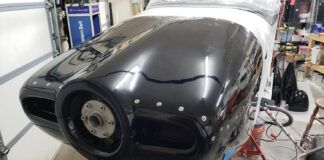
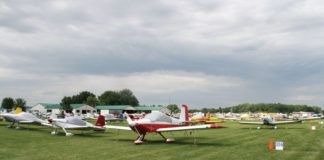

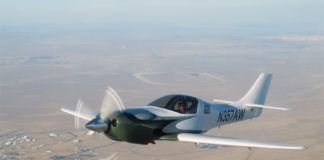
Geoff Jones good morning, please help me find Grinvald Orión Assembly Plant e-mail to buy a Kit, also Jean Dom’s e-mail to contact him to ask his expert advise to build kit.
I look forward to your reply
Best regards, Fernán Febres [email protected], LATAM.
Hallo Fernan,
There is a partially completed Grinvalds Orion for sale on http://www.ebay.de by “Geschwenda” under
Sport
>
Weitere Sportarten
>
Flug- & Drachensport
>
Flugzeugteile
The asking price is €5475
This is the only Grinvalds Orion I know about that is for sale.
Hope this helps, Christopher
I love that this design gives the front seats such a clear and unobstructed view without the wings being in the way. It is truly so sad that designs like this aren’t much more popular. I’d love to see the some of the big name 4-seat aircraft manufacturers of the world take this design and build something awesome. Designs like this one, the Cirrus Vk-30 and the Prescott Pusher are so similar but so awesome. I look forward to the day when these pusher designs get their day in the sun.
I’ve looked at these designs over the years and found that there seems to be a serious problem with stability when trying to recover from a spin as was the case with this aircraft and also the Prescot Pusher , seems like they need a spin recovery chute? Visibility is superb and in some ways similar to the ARV Super 2 and the Bolkow Junior.